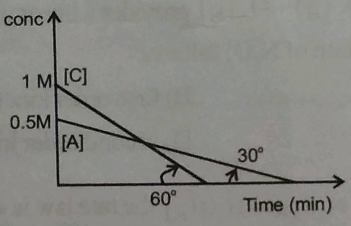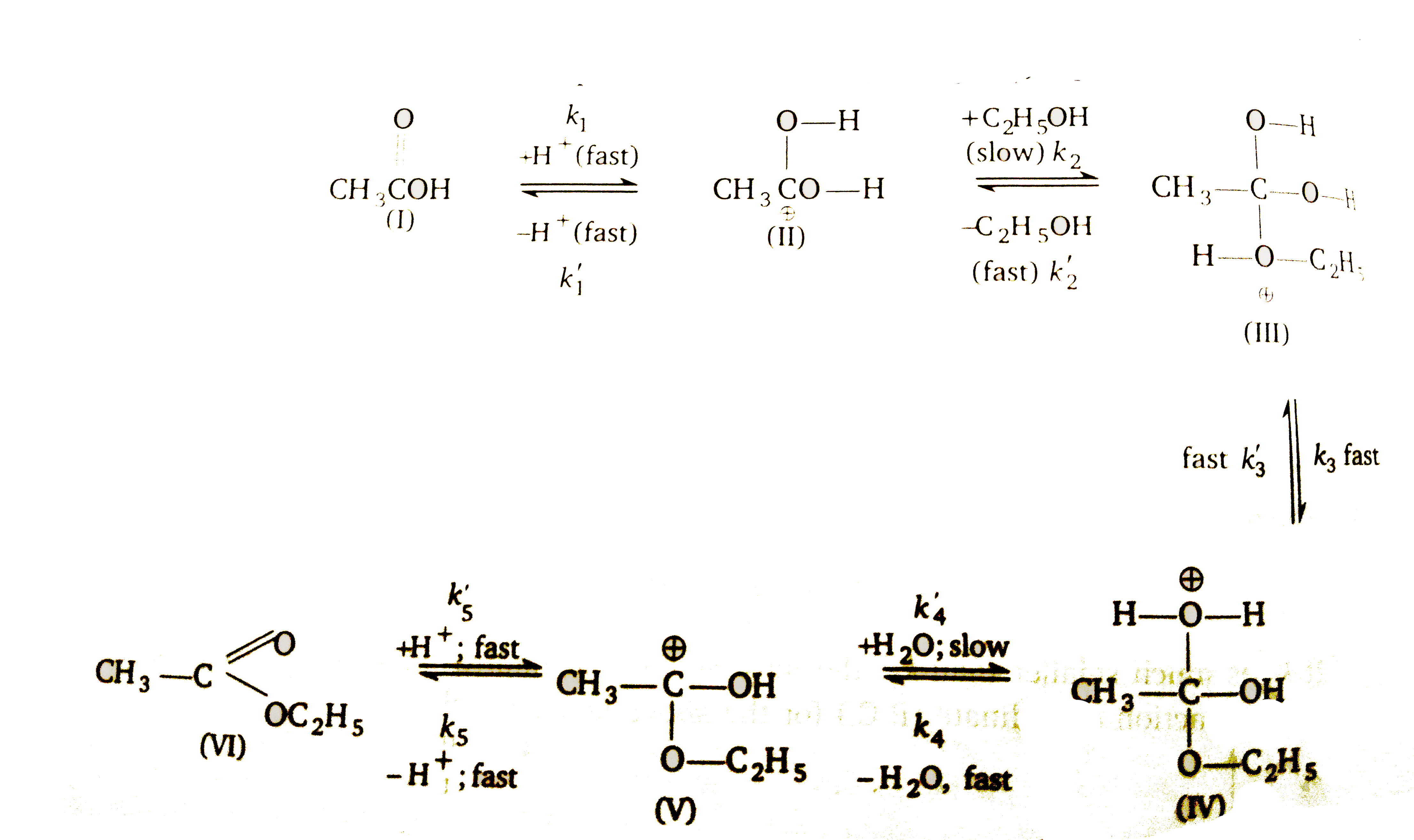Complete Solutions to Level 2 (Q.3 To Q.32) of chapter CHEMICAL KINETIC & NUCLEAR CHEMISTRY of Class 12 book with complete answers and questions
| Class 12 | CHEMISTRY |
| Chapter | CHEMICAL KINETIC & NUCLEAR CHEMISTRY |
| NARENDRA AWASTHI | Level 2 (Q.3 To Q.32) |
| Number Of Questions | 22 |
| Academic Year | 2023-24 |
The kinetic date for the given reaction `A(g)+2B(g)overset(K)toC(g)` is provided in the following table for three experiments at 300 K `{:("Ex. No.","[A/M]","[B/M]","Initial rate" (M sec^(-1))),(1.,0.01,0.01,6.930xx10^(-6)),(2.,0.02,0.01,1.386xx10^(-5)),(3.,0.2,0.02,1.386xx10^(-5)):} ltbgt In another experiment starting swith initial concentration of `0.5` and 1 M respectively for A and B at 300 K, find the rate of reaction after 50 minutes from the starting of edperiment (inM`//`sec).
View SolutionFor the two reactions `I:toBII I:toB,II:CtoD` following graph is obtained.

Which of the following is true:View SolutionThe reaction `A(g)toB(g)+2C(g)` is a first order reaction with rate constant `2.772xx10^(-3)s^(-1)`, Starting with `0.1` mole of A in 2 litre vessel, find the concentration of A after 250 sec when the reaction is allowed to take place at constant pressure and at 300 K?
View Solution`A(aq)rarrB(aq)+C(aq)` is first order reaction.
`"Time"" "t" "oo`
`"moles of reagent " " "n_(1)" "n_(2)`
Reaction prgress is measured with the help of titration of reagent 'R'. If all A, B and C react with reagent and have 'n' factors [n factor,eq. mass=`("mol.mass")/(n)` in the ratio of `1:2:3` with the reagent, the k in terms of `t, n_(1) and `n_(2)` is :View SolutionThe gaseous decomposition reaction, `A(g)rarr2B(g)+C(g)` is observed to first order over the excess of liquid water at `25^(@)C`. It is found that after 10 minutes the total pressure of system is 188 torr and after very long time it is 388 torr. The rate constant of the reaction (in hr`^(-1))` is : [Given : vapour pressure of `H_(2)O` at `25^(@)` is 28 torr (ln`2=0.7`, ln`3=1.1, ln10=2.3)`]
View SolutionThe reaction ,Sucrose`overset(H^(+))rarr` Glucose `+` Fructose, take place at certain temperature while the volume of solution is maintained at 1 litre. At time zero the initial rotation of the mixture is `34^(@)`. After 30 minutes the total rotation of solutions is `19^(@)` and after a very long time, the total roation is `-11^(@) C` Find the time when solution was potically inaactive.
View SolutionA gaseous compound A reacts by three independent first order process (as shown in figure) with rate constant `2xx10^(-3),3xx10^(-3)` and `1.93xx10^(-3) sec^(-1)` for products B, C and D respectively, If initially pure A was taken in a closed container with p=8 atm then the partial pressure of B (in atm) after 100 sec from starting the experiment.
 View Solution
View SolutionA compound A dissociates by two parallel first order paths at certain temperature
`A(g)overset(k_(1)(min^(-1)))to2B(g)" " k_(1)=6.93xx10^(-3)min^(-1)`
`A(g)overset(k_(1)(min^(-1)))toC(g)" " k_(2)=6.93xx10^(-3)min^(-1)`
The reaction is started with 1 mole of pure 'A' litre closed container with initial pressure 2 atm. What is the pressure (in atm) developed in container after 50 minutes from start of experiment?View SolutionFor given hypothetical elementary parallel reaction,

Intially only 2 moles of A are present. The total no. of moles of A, B and C at the end of `75%` reaction are:View SolutionThe reaction cis-Xcis-X`underset(k_(b))overset(k_(f))ltimplies` trans-X is first order in both direction At `25^(@)C,` the equilibrium constant is `0.10` and the rate constant `k_(f)=3xx10^(-4)s^(-1)` In an experiment starting with the pure cis- from , how long would it take for half of the equilibrium amount of the trans-iomer to be fromed?
View SolutionConsider the reaction.

The rate constant for two parallel reactions were found to be `10^(-2) dm^(-2)mol^(-1)s^(-1)` and `4xx10^(-2)dm^(-3)mol^(-1)s^(-1)` . If the corresponding energies of activation of the parallel reaction are 100 and 120 kJ/mol respectively, what is the net energy of activation `(E_(a))` of AView SolutionA reaction takes place in various steps. The rate constatn for first, second, third and fifth steps are `k_(1),k_(2),k_(3)` and `k_(5)` respectively The overall rate constant is given by
`k=(k_(2))/(k_(3))(k_(1)/(k_(5)))^(1//2)`
If activation energy are 40, 60, 50, and 10 kJ/mol respectively, the overall energy of activation (kJ/mol) is :View SolutionFor reaction `ArarrB,` the rate constant `k_(1)=A_(1)^(-Ea_(1//(RT)))` and for the reactio `XrarrY,` the rate constant `k_(2)=A_(2)^(-Ea_(1//(RT)))` . If `A_(1)=10^(8),A_(2)=10^(10)` and `E_(a_(1))=600` cal /mol, `E_(a_(2))=1800` cal/mol then the temperature at which `k_(1)=k_(2)` is (Given :R=2 cal/K-mol)
View SolutionFor first order parallel reactions `k_(1)` and `k_(2)` are 4and `2min(-1)` respectively at 300 K. If the activation energies for the formation of B and C are respectively 30,00 and 38,314 joule/ mol respectively, the temperature at which B and C will be obtained in equimolar ratio is :
 View Solution
View SolutionIn the series reaction
`Aoverset(K_(2))(rarr)Boverset(K_(2))(rarr)Coverset(K_(2))(rarr)D` , if `K_(1)gtK_(2)gtK_(3)` then the rate determing step of the reaction isView SolutionThe mechanism of esterification in presence of acid catalyst `(H_(2)SO_(4))` is proposed as follows:

Which of the following potential energy `Vs` reaction co-ordinate diagram is consitent with given mechanism ?View SolutionFor the first order reaction `ArarrB+C` , carried out at `27^(@)C` if `3.8xx10^(-16)%` of the reactant molecules exists in the activated state, the `E_(a)` (activation energy) of the reaction is :
View SolutionUpon irradiating californium with neutrons, a scientist discovered a new nuclide having mass number of 250 and a half-life of 30 min. After 90 min. of irradiation, the observed radioactivity due to nuclied was 100 dis/min. How many atoms of the nucliede were prepared intially?
View SolutionThe average (mean) life of a radio nuclide which decays by parallel path is
`Aoverset(lambda_(1))(rarr)B` : `lambda_(1)=1.8xx10^(-2)sec^(-1)`
`2Aoverset(lambda_(2))(rarr)B` , `lambda_(2)=10^(-3)sec^(-1)`View SolutionThe radioactive decay `._(83)^(211)Birarr_(81)^(207)Ti` , takes place in 100L closed vessel at `27^(@)C` Starting with 2 mols of `_(83)^(211)Bi(t_(1//2)=130sec)` , the presuure development in the vessel after 520 sec will be:
View SolutionA fresh radioactive mixture contians short lived sppecies A and B. Both emitting `alpha`-particles intially of 8000 `alpha` particles per minute. 20 minutes later, they emis at the rate of 3500 `alpha` -particles per minute. If the half-lives of the species A and B are 10 minutes and 500 hours respectively, then the ratio of activities of A: B the intial mixture was:
View SolutionIn order to determine the volume of blood in an animal, a `1.0`mL sample of solution of `10^(3)` dpm of `._(1)^(3)H` is injected into the animal blood stream. After sufficient time for circulatory equilibrium to be established, 2mL of blood is found to have activity to 10 dpm. The volume of blood in animal is :
View Solution
Level 2 (Q.3 To Q.32) questions and complete solutions for chapter CHEMICAL KINETIC & NUCLEAR CHEMISTRY of NARENDER AVASTHI CHEMISTRY (HINGLISH) of Class 12
All Exercises from NARENDRA AWASTHI Class 12 CHEMISTRY CHEMICAL KINETIC & NUCLEAR CHEMISTRY
- Exercise
- Level 1 (Q.123 To Q.150)
- Level 1 (Q.3 To Q.32)
- Level 1 (Q.33 To Q.62)
- Level 1 (Q.63 To Q.92)
- Level 1 (Q.93 To Q.122)
- Level 2
- Level 2 (Q.3 To Q.32)
- Level 2 (Q.33 To Q.35)
- Level 3 - Assertion - Reason Type Questions
- Level 3 - One Or More Answers Are Correct
- Level 3 - Passage
- Level 3 - Subjective Problems
